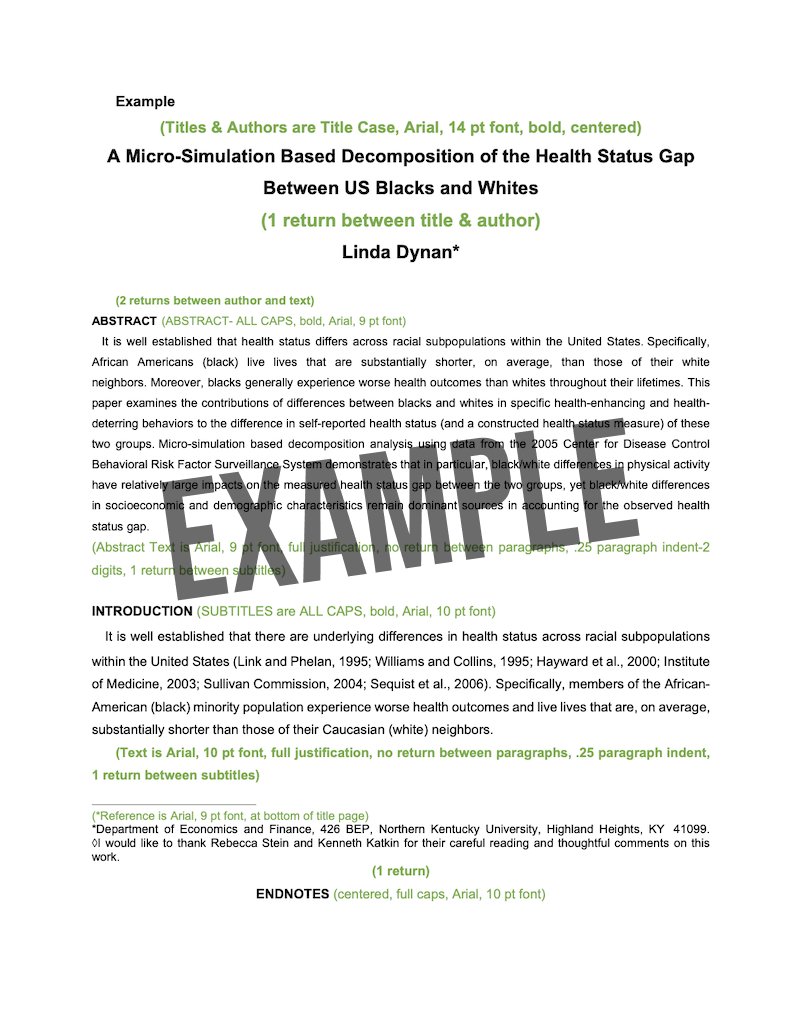Guidelines for the Submission of Papers
General Instructions
The paper must be submitted using Microsoft Word. Papers in any other format, including WordPerfect, will not be accepted. If you have to convert a file to Word, check that quotation marks (“), apostrophes (‘), and other symbols come out as intended after the conversion (including all mathematical equations). If they do not, change them manually before submitting the paper.
Papers must be prepared according to the guidelines below; papers submitted absent broad adherence to these guidelines will be returned to the authors, for editing and resubmission.
Papers are limited to no more than 30 pages, including tables, figures, and appendices.
Specific Instructions
Organize the sections of your paper as follows: (a) abstract, (b) main body, (c) acknowledgments, (d) endnotes, (e) references, (f) appendices.
- Use 1” margins on all sides. Do NOT include page numbers. Indent the first line of all paragraphs 0.25 inches from the left margin. Fully justify text throughout the body of the paper. Include all tables and figures exactly where you want them to be located in the text. Text should be set on Arial 10 point font. Line spacing should be set at 1-1/2.
- Set the title and author(s) name(s) in Arial 14 point font, bold, and centered. Leave only one return between title and author. Capitalize only the first letter of each word. Below the title, write the names of the authors with an asterisk and place the author(s) affiliation at the end of the paper.
- The text of the abstract should be in Arial 9 point font, fully justified, and with line spacing set at 1-1/2. Leave two returns between the author and heading, and one return between the heading and the abstract. The heading ABSTRACT should be left justified. Do not exceed 100 words for the abstract.
- For the main text, use Arial 10-point font, 1-1/2 line spacing. Leave only one space between sentences, not two! Do not leave a blank line between paragraphs. Heading titles should be left justified, all caps, bold. Leave one return between the heading or subheading and the next line. Leave a blank line before and after all headings and subheadings.
- All references to books, articles, monographs, etc., should be identified at the appropriate point in the text by the last name of the author and year of publication, e.g. (Author, 1995). Add page numbers when ideas are used or words are quoted, e.g. (Author, 1995, pp. 302-304). When an author’s name is used as part of the text, set only the date in parentheses, with page number if necessary, e.g. Author (1995) and Author (1995, pp. 302-304). If more than one work by the same author is cited for the same year, use a, b, etc. behind the year, e.g., Martin (1991a).
- Use endnotes, not footnotes. Keep their number to an absolute minimum. Center and bold the heading of the endnotes entitled ENDNOTES in 10 pt. font. Use regular size Arabic numerals followed by a period point to number endnotes. Indent the text of each endnote by 0.25 inches from the left margin. Use 1-1/2 line spacing and leave one blank line between the endnotes. Do not start a new page.
- List all items cited in alphabetical order after the endnote in a separate section entitled REFERENCES (do not number the references) with the heading centered in 10 pt. font. Citations should be fully justified. If a citation does not fit on one line, indent additional lines 0.25 inches from the left margin. Leave a space between references (see example at the end). The references are sorted by Author + Year + Title; make use of a letter after the year to distinguish citations of the same author in the same year, e.g. 1978a, 1978b. The names of books and journals should be placed in italics – NOT underlined.
- Center and bold the heading of the APPENDIX in 10 pt. font. Do not start a new page. Tables and figures should be placed here only if you cannot place them in the body of the paper.
- Please try to avoid long tables. Summarize the results and make the table available on request.
Shorter tables need to be inserted in the text where you want them to be placed. There are no vertical lines anywhere in the table and all text is in 10 pt. font. The heading of the table should give a number to the table (in bold) and a title (non-bold). Leave spaces between lines only if absolutely necessary. Explanatory notes appear in 9 pt. font at the bottom of each table, below a horizontal line, not at the top of the table, and not above the last horizontal line. An example is given below.

- Figures that are not essential should be avoided! Insert all figures in the text where they should appear. If that is not possible, put them at the end. That is also where they will be printed. Headings and notes need to be in the same style as those for the tables. The background for all figures should be white. If a table or graph or ANY IMAGE has been scanned or taken from the internet or any other outside source, it will be deleted from the text of your submission.
- Name your file as the last name of the first author underscore the last name of the second author (and so on) underscore 2010:
Vogel_Jones_2010.
